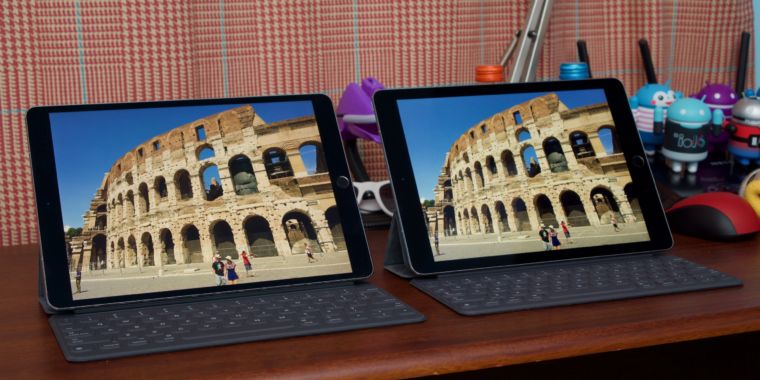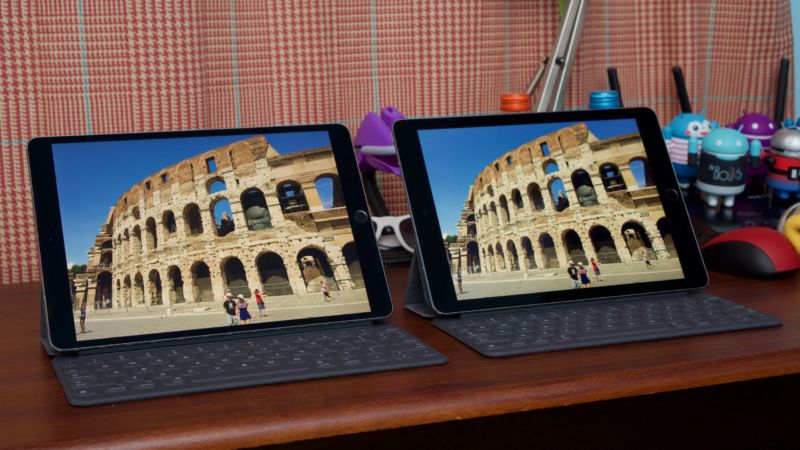

Andrew Cunningham
This coming Tuesday, Apple will host its second live product announcement event of the fall. While September’s event focused on three new iPhone models and an updated Apple Watch, we expect this event to include updates to the iPad Pro that would add new power user features and bring the device closer in design to the company’s latest iPhones. We wouldn’t be surprised to see some new Macs, too.
The event will take place at the Howard Gilman Opera House and Brooklyn Academy of Music. The last event was at Apple’s headquarters in Cupertino, but it’s not unusual for the company to branch out to new locations that fit the theme of the products being introduced. For example, the company introduced its education-targeted iPads at a school in Chicago earlier this year.
To that point, creative work seems to be the implied focus of the products coming this week. There’s the venue, yes, but Apple also accompanied members of the press’ invitation with the words “there’s more in the making” and a series of artists’ renditions of its logos in various styles, pictured here.
-
One of several styled Apple logos associated with the October 30 event. -
Another one of several styled Apple logos associated with the October 30 event. -
You may sense a theme coming in this gallery… -
One of several styled Apple logos associated with the October 30 event. -
One of several styled Apple logos associated with the October 30 event. -
One of several styled Apple logos associated with the October 30 event. -
One of several styled Apple logos associated with the October 30 event. -
One of several styled Apple logos associated with the October 30 event. -
One of several styled Apple logos associated with the October 30 event. -
One of several styled Apple logos associated with the October 30 event.
While the iPhone remains a broad consumer product, Apple has increasingly oriented marketing and design choices around Macs towards fields like this. Creative work can be a big umbrella, though. In addition to obvious crafts like music and art, it can also mean software development, writing, Web design, some kinds of work in scientific disciplines, and more.
Apple used to be known for its iron grip on information about its new products before launch, but that grip has weakened in recent years. We’ve seen compelling reports that shed some light on upcoming products, so let’s go over each thing we expect to see.
Definitely
New iPad Pro models
If there’s one thing we’re confident in about Apple’s October 30 event, it’s that new iPad Pro models are coming. They’ll most likely come in the same two sizes already offered: 10.5 and 12.9 inches.
Both reports from Bloomberg and details testers have discovered in iOS betas have led us to believe that the new iPad Pro models will feature near-edge-to-edge displays and the TrueDepth sensor array (used for Face ID and other applications) seen in the iPhone X, XS, XS Max, and XR. An icon spotted in an iOS beta seemed to suggest there won’t be a notch, but we’ll see. Users and developers poking around in iOS have determined that the new iPads will most likely support Face ID in both landscape and portrait orientations, whereas the iPhone’s Face ID feature only works in portrait.

Andrew Cunningham
Apple already updated the iPad user interface in iOS 12 to support the gestures that replaced the home button in the iPhone X, so the software groundwork is largely there for the new iPad Pros.
We’re not as sure about this one, but sources have told 9to5Mac that the new iPad Pro models will ditch Apple’s proprietary Lightning connector in favor of USB-C, and that this would enable pushing 4K external displays from the iPad Pro. That’s something designers and artists would probably be delighted to see if it’s well-implemented. The report also said that the smart keyboard connector could be moved, but we’ve seen conflicting information on that detail.
The previous iPad Pro had a chip Apple called the A10X—its basic architecture was the same as the A10 used in the iPhone 7, but the chip featured numerous significant improvements in performance and additional features, particularly in video. We’re expecting something similar here, just newer. Apple will probably call the chip either the A11X or the A12X.
Probably
A MacBook or MacBook Air replacement
This is another one based on a Bloomberg report, though it shouldn’t surprise to anyone following Apple’s product offerings closely. The word is that Apple plans to introduce a new MacBook or MacBook Air replacement; we’re not sure which product the new laptop will replace, but it might be both in an effort to consolidate the two lines. The new laptop would resemble the MacBook Air in basic design, but it would have a Retina display and smaller bezels.
-
This is the current MacBook Air design, though this photo was taken way back in 2014. The Air hasn’t changed since then. But rumors suggest that it’s about to. -
This is the current MacBook design. It’s smaller than the MacBook Air and has a Retina display. However, it’s pricy, and it only has one port for peripherals. -
Remember this keyboard? Today’s MacBook Air still has it. -
Chances are the next MacBook will have the butterfly design pictured here (from the 2017 MacBook), but here’s hoping it will apply the same improvements found in the 2018 MacBook Pro.
It stands to reason that a new MacBook would support Thunderbolt 3 and include Apple’s ever-evolving butterfly keyboard mechanism—the latter of which didn’t exactly impress consumers when it was first introduced, but it has improved with iteration. Here’s hoping any new laptop has more than one port, making it more like the MacBook Air than the limited-use MacBook.
An Intel CPU is likely, but there is an outside possibility that Apple will introduce its own custom-made CPU in this machine. We’ve seen reports suggesting that’s inevitable, and it makes sense given Apple’s overall strategy. The company moved to custom CPUs in the iPhone and iPad, and its silicon crushes the competition in benchmarks, making the value proposition clear. Still, there are deeper concerns about legacy software support on the Mac platform, so Apple needs to tread carefully. It seems like it’s still too soon for this in 2018, but you never know.
In any case, expect the device to be priced around $1,000—or even a little lower. Business professionals, college students, and general consumers would be the target users.
A new Mac mini (no, really)
That same report included another suggestion: Apple is working on a brand new Mac mini. The product has languished with ancient hardware since 2014, but Tim Cook promised a customer in an email around this time last year that this form factor was a part of Apple’s future plans.
The Bloomberg report didn’t provide many details, but it did reveal how the product would be positioned. The new Mac mini would have more powerful hardware than its predecessor (above and beyond the fact it would just be newer) with a steeper price. Apple would pitch it as an entry-level or secondary machine for software developers, musicians, and artists who want to use applications like Xcode, Logic, or Adobe Illustrator.
-
The 2014 Mac mini is pictured here alongside the 2012 Mac mini. They looked the same, but the insides were different in some key—and disappointing—ways. -
For one thing, serviceability took a hit. The 2014 machine was harder to open up and work on than its predecessor, and the RAM was soldered to the motherboard. -
The 2014 model dropped the quad-core CPU option, leading to benchmarks like this that showed the 2012 model outperforming it. -
A similar disparity was found in this video export test.
That makes sense. The product was originally at least partly positioned as a home theater PC, but those devices have gone the way of the dinosaurs thanks to streaming boxes like the Apple TV, video game consoles, and smart TVs. Apple is pushing educational programs like Everyone Can Code and Everyone Can Create to recruit developers and creatives to its devices, but the buy-in for a MacBook Pro or iMac is very steep. The company’s efforts to pitch macOS as the platform of choice for those users will be more successful if a cheaper machine like this is offered.
It’s also worth noting that many people were unhappy with the 2014 Mac mini. It offered fewer options for power users that needed power and serviceability. Hopefully Apple won’t make the same mistake again.








